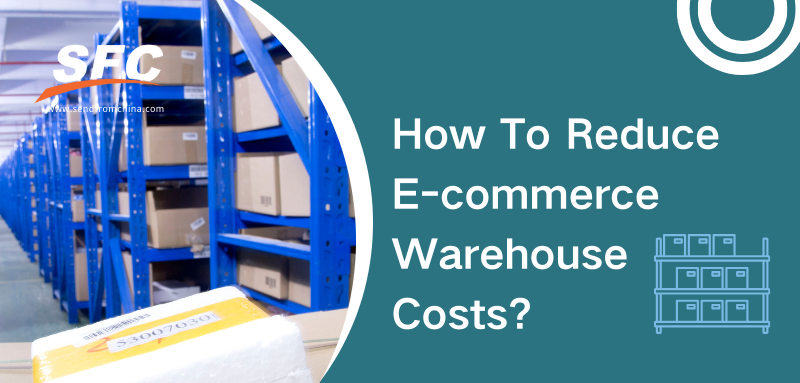Table of Contents
Get Custom eCommerce Fulfillment Service
Book a Meeting
How To Reduce E-commerce Warehouse Costs?
Time: Mar 29,2024 Author: SFC Source: www.sendfromchina.com
Streamlining and managing a warehouse constitute a considerable share of your ecommerce business's operational costs, deeply affecting your profit margins. As you weigh the options of leasing or purchasing a warehouse, understanding these expenses is critical. Enhancing your warehouse efficiency can significantly boost your brand's profitability, though it might be challenging.
This is why we've prepared a detailed guide to help you grasp the different facets of warehouse costs, explain how pricing for warehousing is determined, and aid in deciding whether to rent or buy. Additionally, we will guide you on how to fine-tune your warehouse expenses to ensure they do not diminish your profits. Let’s embark on this journey.
This is why we've prepared a detailed guide to help you grasp the different facets of warehouse costs, explain how pricing for warehousing is determined, and aid in deciding whether to rent or buy. Additionally, we will guide you on how to fine-tune your warehouse expenses to ensure they do not diminish your profits. Let’s embark on this journey.

Content Table
1. What Makes Warehouse Costs
2. How to Calculate Warehouse Costs
3. How to Reduce Warehouse Costs
4. Get Better Fulfillment Service from SFC
5. FAQs
1. What Makes Warehouse Costs
Warehouse costs encompass a wide range of operational expenses beyond just leasing space. These include both fixed and variable costs, which can fluctuate monthly, impacting the total operational cost of a warehouse. Understanding these costs in detail is critical for managing a supply chain efficiently. It offers insight into the actual costs of inventory storage and highlights areas where cost reductions can be achieved. Let’s explore the primary components that drive warehouse costs.
Rent or Mortgage Payments: The cost of leasing or buying the warehouse space. This is often one of the largest expenses and varies significantly based on location, size, and facilities.
Utilities: Expenses for electricity, water, heating, and cooling. Warehouses with temperature control requirements (e.g., for food or pharmaceuticals) can have significantly higher utility costs.
Maintenance and Repairs: Regular upkeep to maintain the warehouse in good condition, including repairs for equipment like forklifts, conveyor belts, and the building's infrastructure (roof, walls, docks).
Labor Costs: Salaries and benefits for warehouse staff, including pickers, packers, managers, and security personnel. Labor costs can vary widely based on the level of automation, the complexity of operations, and the geographical location.
Rent or Mortgage Payments: The cost of leasing or buying the warehouse space. This is often one of the largest expenses and varies significantly based on location, size, and facilities.
Utilities: Expenses for electricity, water, heating, and cooling. Warehouses with temperature control requirements (e.g., for food or pharmaceuticals) can have significantly higher utility costs.
Maintenance and Repairs: Regular upkeep to maintain the warehouse in good condition, including repairs for equipment like forklifts, conveyor belts, and the building's infrastructure (roof, walls, docks).
Labor Costs: Salaries and benefits for warehouse staff, including pickers, packers, managers, and security personnel. Labor costs can vary widely based on the level of automation, the complexity of operations, and the geographical location.
Equipment and Technology: Investments in shelving, racking, forklifts, and technology like warehouse management systems (WMS), barcode scanners, and automation technology. These costs can be upfront or ongoing, depending on whether the equipment is purchased or leased.
Insurance: Coverage for the building, contents, liability, and workers' compensation. Insurance costs depend on the value of the goods stored, the warehouse activities, and the risk level of the location.
Order Fulfillment: Order fulfillment expenses, covering packaging materials and shipping, are key drivers of warehouse costs. Customizing the unboxing experience with unique packaging or promotional inserts further adds to these fulfillment costs.
2. How To Calculate Warehouse Cost
Calculating warehouse costs hinges on your pricing model and ownership status of the warehouse space. Key considerations usually involve the lease or purchase rate on a monthly or annual basis, alongside anticipated expenses for warehouse operation.
3. How to Reduce Warehouse Costs
Optimizing warehouse costs involves implementing strategies to increase efficiency and reduce unnecessary expenses. Here are several approaches to consider:
Evaluating Your Warehouse Needs
Begin by examining your current warehouse space to accurately evaluate your storage needs. This step will help you determine if your spending aligns with your actual requirements.
Reflect on whether you truly need the full extent of the space you’re leasing, if you’re overinvesting in storing slow-moving items, or if relocating some inventory offsite or using a consolidation warehouse could reduce shipping costs.
These critical questions will lead to a clearer understanding of your warehousing expenses, guiding you to identify and implement adjustments to lower your overall costs.
Reflect on whether you truly need the full extent of the space you’re leasing, if you’re overinvesting in storing slow-moving items, or if relocating some inventory offsite or using a consolidation warehouse could reduce shipping costs.
These critical questions will lead to a clearer understanding of your warehousing expenses, guiding you to identify and implement adjustments to lower your overall costs.
Optimize Your Warehouse Space
Improving warehouse space efficiency is a key step in lowering costs, focusing on maximizing existing space to enhance spending efficiency. Essentially, you aim to reduce storage costs while increasing inventory capacity.
This can be achieved by redesigning the warehouse layout and updating storage systems for higher inventory volume. Consider transitioning to Automated Storage and Retrieval Systems (AS/RS) to leverage vertical space more effectively. Additionally, exploring various advanced storage solutions can further boost your capacity to store more inventory efficiently.
This can be achieved by redesigning the warehouse layout and updating storage systems for higher inventory volume. Consider transitioning to Automated Storage and Retrieval Systems (AS/RS) to leverage vertical space more effectively. Additionally, exploring various advanced storage solutions can further boost your capacity to store more inventory efficiently.
Avoid Overstocking
Overstocking, especially slow-moving items, occupies valuable space and ties up capital in stock that isn't selling, increasing holding costs. To cut down on ecommerce warehouse expenses, preventing overstocking is essential. Achieve this by accurately forecasting inventory needs, and adjusting for shifts in consumer demand. Strategically manage procurement based on these forecasts to avoid acquiring more inventory than needed.
Improve Inventory Turnover
Reducing warehouse costs significantly involves preventing the buildup of goods at various stages within the warehouse. It's crucial to ensure a streamlined inventory turnover, allowing goods to quickly advance to subsequent supply chain stages rather than consuming valuable warehouse space. Achieve this by strategically organizing your warehouse layout to mirror the inventory's natural flow. For instance, situating fast-moving items near shipping docks simplifies access, ensuring these goods are promptly processed and dispatched, and keeping the warehouse flow efficient.
Outsourcing Fulfillment
Handling warehousing operations internally, including the acquisition or leasing of space and operational expenses, can escalate costs, particularly with multiple sites in different locales. Outsourcing these functions to a third-party logistics (3PL) provider can be a more cost-effective strategy.
3PL services eliminate the necessity for your own warehouse space, offering substantial savings. This approach not only reduces overhead expenses but also slashes your overall warehousing costs. 3PLs handle order fulfillment and navigate the complexities of inventory and warehouse management, sparing you the expense and effort of expanding your warehouse workforce.
3PL services eliminate the necessity for your own warehouse space, offering substantial savings. This approach not only reduces overhead expenses but also slashes your overall warehousing costs. 3PLs handle order fulfillment and navigate the complexities of inventory and warehouse management, sparing you the expense and effort of expanding your warehouse workforce.
4. Get Better Fulfillment Service from SFC
SFC—Your trusted third-party logistics service provider in China. We are committed to optimizing logistics strategies for customers manufacturing in China, delivering orders directly from China to global consumers with low logistics costs and fast delivery times. Click the button below and get help from SFC logistics experts.
1. Over 17 years 3PL and order fulfillment experience
2. DDP (Delivered Duty Paid) Service
3. All-in-one tracking number
4. API
5. 30 days of free storage
6. No hidden fee
7. Custom packaging
8. Worldwide shipping solutions

5. FAQs
1. What is Supplier Relationship Management (SRM)?
SRM is a strategic approach to managing an enterprise's interactions with the organizations that supply the goods and services it uses. The goal is to streamline and make more effective the processes between an enterprise and its suppliers.
2. Why is Supplier Relationship Management important?
Effective SRM can lead to lower costs, improved quality, greater efficiency, and the development of value-added services and innovations. It also fosters stronger, more beneficial relationships with suppliers.
3. How does technology impact Supplier Relationship Management?
Technology plays a crucial role in SRM by enabling better communication, increasing transparency, facilitating real-time performance monitoring, and supporting collaborative innovation efforts.
4. What are some challenges in Supplier Relationship Management?
Challenges include managing a diverse supplier base, ensuring compliance and ethical standards, overcoming communication barriers, and adapting to rapid technological changes.
5. How can businesses overcome challenges in Supplier Relationship Management?
Overcoming SRM challenges requires a focus on clear communication, understanding and respecting diversity, leveraging technology for better management and collaboration, and committing to continuous improvement and ethical practices.
 Post Views:5937
Post Views:5937
Copyright statement: The copyright of this article belongs to the original author. Please indicate the source for reprinting.
Previous Post
Dropshipping Marketing Strategy: 8 Tips To Market Your Dropshipping Store 2025
Next Post
TAGS
Hot Research
Recent News
- Third Party Logistics Definition, Process, and Advantages
- What Is Ecommerce Fulfillment? The Definition, Process, and Benefits
- Where Does Shein Ship From
- Why DHL Express Is the Best Courier for Fast International Shipping in 2026
- FedEx International Economy Shipping Guide: Rates, Speed, and Business Benefits
Get Custom eCommerce Fulfillment Service
Book a Meeting
Get a Custom China Fulfillment Solution with FREE Storage for 30 Days
 Want to know about our services, fees or receive a custom quote?
Want to know about our services, fees or receive a custom quote?
 Please fill out the form on the right and we will get back to you within a business day.
Please fill out the form on the right and we will get back to you within a business day.
 The more information you provide, the better our initial response
will be.
The more information you provide, the better our initial response
will be.





 TAGS:
TAGS: